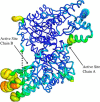Direct evidence that an extended hydrogen-bonding network influences activation of pyridoxal 5'-phosphate in aspartate aminotransferase
- PMID: 28232482
- PMCID: PMC5392587
- DOI: 10.1074/jbc.M116.774588
Direct evidence that an extended hydrogen-bonding network influences activation of pyridoxal 5'-phosphate in aspartate aminotransferase
Abstract
Pyridoxal 5'-phosphate (PLP) is a fundamental, multifunctional enzyme cofactor used to catalyze a wide variety of chemical reactions involved in amino acid metabolism. PLP-dependent enzymes optimize specific chemical reactions by modulating the electronic states of PLP through distinct active site environments. In aspartate aminotransferase (AAT), an extended hydrogen bond network is coupled to the pyridinyl nitrogen of the PLP, influencing the electrophilicity of the cofactor. This network, which involves residues Asp-222, His-143, Thr-139, His-189, and structural waters, is located at the edge of PLP opposite the reactive Schiff base. We demonstrate that this hydrogen bond network directly influences the protonation state of the pyridine nitrogen of PLP, which affects the rates of catalysis. We analyzed perturbations caused by single- and double-mutant variants using steady-state kinetics, high resolution X-ray crystallography, and quantum chemical calculations. Protonation of the pyridinyl nitrogen to form a pyridinium cation induces electronic delocalization in the PLP, which correlates with the enhancement in catalytic rate in AAT. Thus, PLP activation is controlled by the proximity of the pyridinyl nitrogen to the hydrogen bond microenvironment. Quantum chemical calculations indicate that Asp-222, which is directly coupled to the pyridinyl nitrogen, increases the pKa of the pyridine nitrogen and stabilizes the pyridinium cation. His-143 and His-189 also increase the pKa of the pyridine nitrogen but, more significantly, influence the position of the proton that resides between Asp-222 and the pyridinyl nitrogen. These findings indicate that the second shell residues directly enhance the rate of catalysis in AAT.
Keywords: X-ray crystallography; enzyme catalysis; hydrogen bond; pyridoxal phosphate; quantum chemistry.
© 2017 by The American Society for Biochemistry and Molecular Biology, Inc.
Conflict of interest statement
The authors declare that they have no conflicts of interest with the contents of this article
Figures








References
-
- Toney M. D. (2005) Reaction specificity in pyridoxal phosphate enzymes. Arch. Biochem. Biophys. 433, 279–287 - PubMed
-
- Oliveira E. F., Cerqueira N. M., Fernandes P. A., and Ramos M. J. (2011) Mechanism of formation of the internal aldimine in pyridoxal 5′-phosphate-dependent enzymes. J. Am. Chem. Soc. 133, 15496–15505 - PubMed
-
- Hayashi H., and Kagamiyama H. (1997) Transient-state kinetics of the reaction of aspartate aminotransferase with aspartate at low pH reveals dual routes in the enzyme-substrate association process. Biochemistry 36, 13558–13569 - PubMed
Publication types
MeSH terms
Substances
Associated data
- Actions
- Actions
- Actions
- Actions
- Actions
LinkOut - more resources
Full Text Sources
Other Literature Sources
Molecular Biology Databases
Research Materials
Miscellaneous

